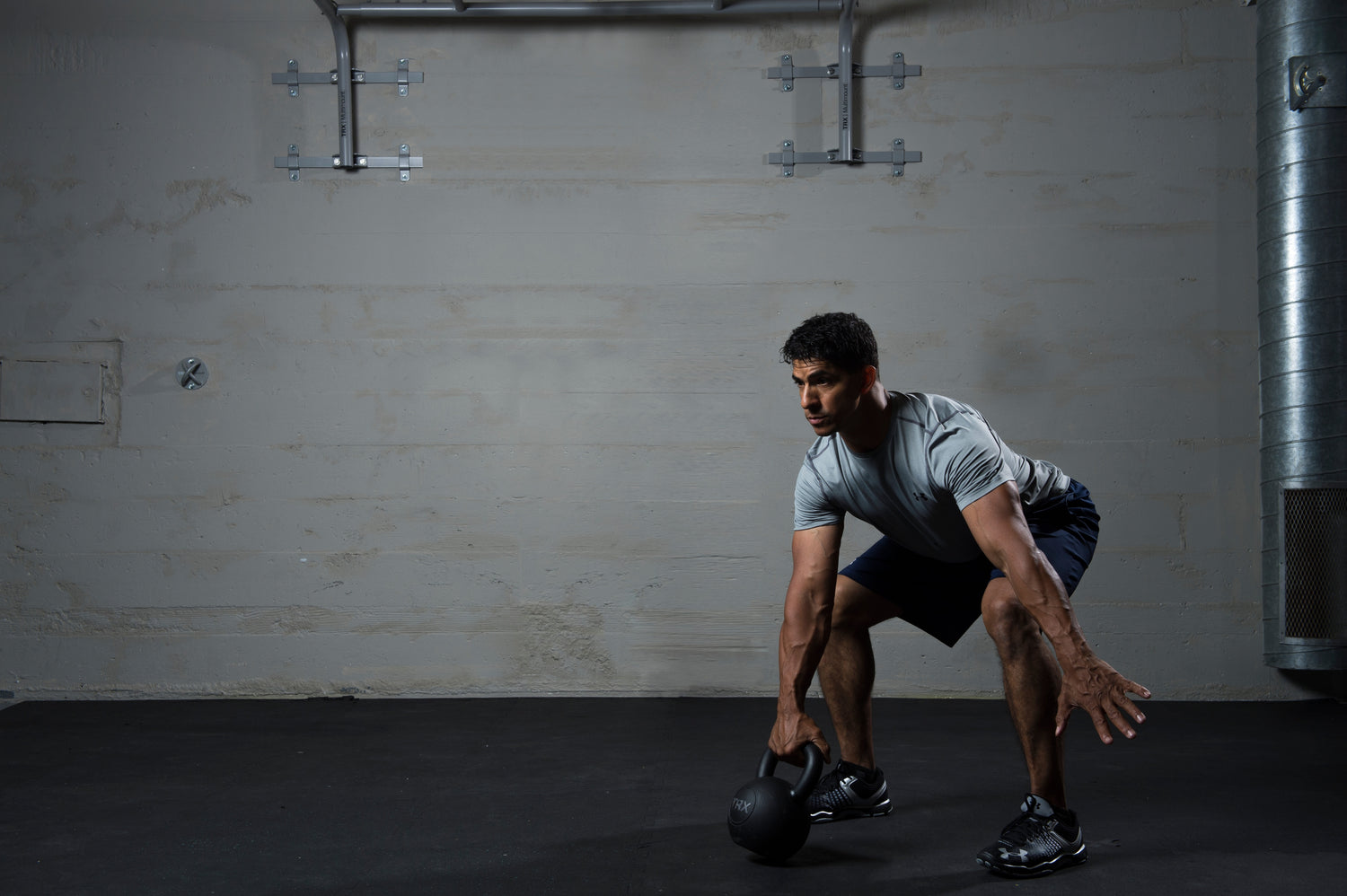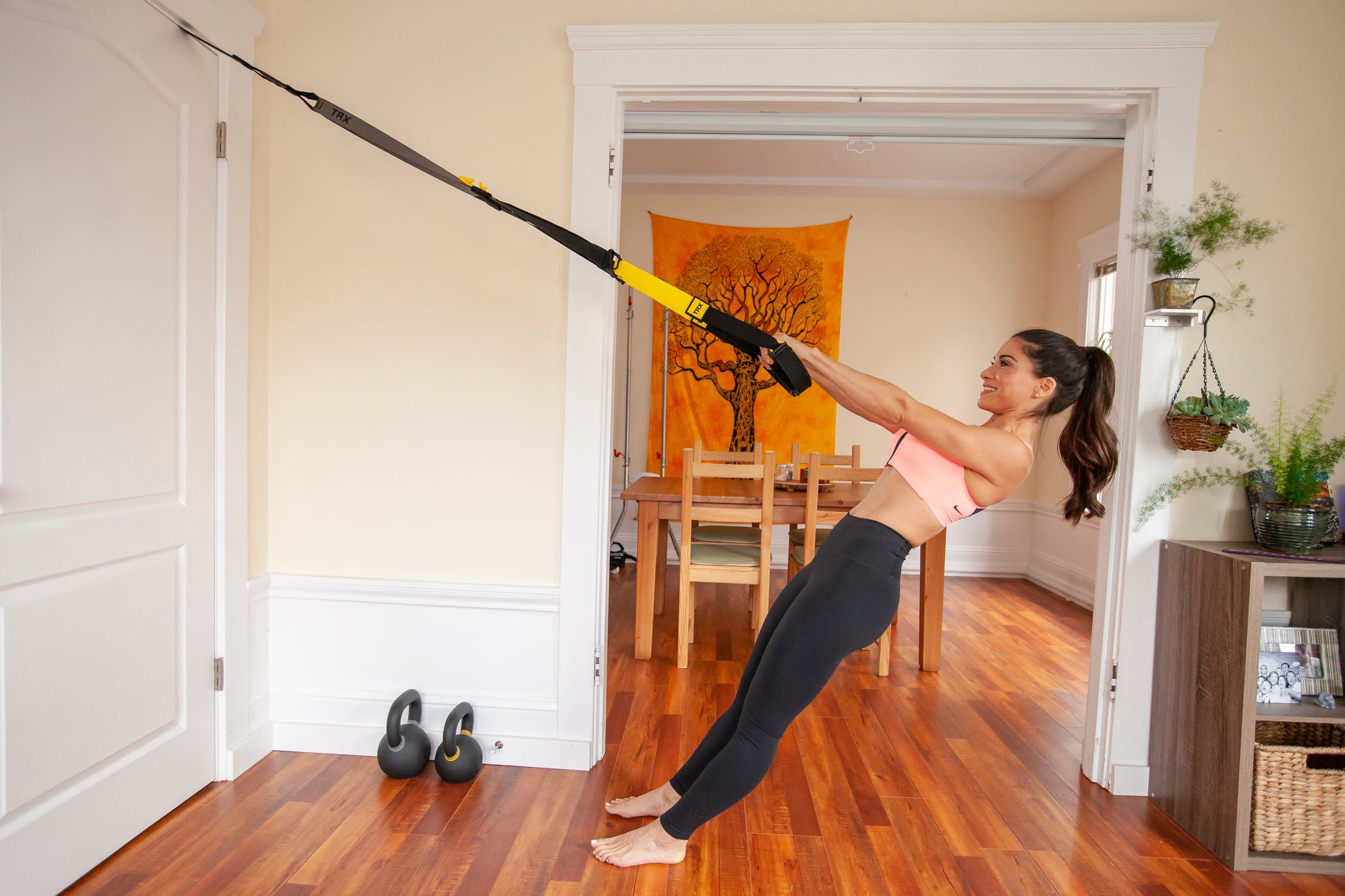The biggest obstacle to breaking in new workout gear is usually deciding where to start. So let’s alleviate that decision paralysis right now. When you’re looking for ways to begin working with your TRX Gravity Cast Kettlebells, turn to these four beginner moves.
But first, Kettlebells 101
A kettlebell has more parts than you might expect for a solid chunk of metal, and learning what to call all of the whatsits will help you understand basic kettlebell exercises.
Think of the top grip of a kettlebell as a giant “C.” The center bar of the grip is called the handle, while the curves at the sides of the handle are known as the corners. The tips of the “C”—where the kettlebell connects to the bulb that accounts for most of the weight—are known as the horns. The horns connect to the bell, and the flat bottom of the bell is called the base.
TRX Kettlebells are gravity-cast with a smooth, powder-coated finish to ensure that the burn you feel comes from your workout, not from friction in your grip.
Speaking of workouts, let’s get down to business.
Hey! I want to do a Turkish Get-up!
Don’t we all?
Patience, young padawan. You have to nail the fundamentals before you progress into the advanced moves. It’s also important to remember that moving with a kettlebell may feel awkward when you’re getting started. That’s because a kettlebell is designed to engage in its own trajectory of movement that complements your movement.
Think of it like walking with a full glass of water: with each step, the water is going to engage in its own pattern of movement; maybe even slosh over the glass. Similarly, a kettlebell’s handle is meant to rotate as an axle inside your grip. One of the reasons that kettlebell workouts are effective is your body has to respond to and counterbalance the kettlebell’s independent momentum.
In other words, it’s best to start with the simple exercises to understand how exercising with a kettlebell feels before charging into the advanced challenges.
Let’s give it a go.
The Kettlebell Deadlift
Start with your feet hip-distance apart, and your TRX Kettlebell on the ground in front of your toes. Hinge at your hips, pushing your butt back as you do, and try to minimize the bend in your knees. Grab the kettlebell handle by the corners, and start your return to a standing position. As you straighten your body, you’ll be powering that lift through the posterior chain. (That’s the official name for the muscle groups in your backside.)
Continuing to grip the kettlebell by the corners, and repeat that hinge-and-extend motion. Focus on keeping your back flat and your shoulders pulled down and back. You don’t have to touch the kettlebell to the floor with each rep; if your hamstrings are tight, your terminal point for the deadlift might be around your shins or ankles. That’s okay!
Goblet Clean
In this move, you’ll change your grip on the kettlebell while maintaining fluid motion.
Start again with feet at hip-distance and the kettlebell slightly in front of your toes. Squat down and grab the kettlebell by the corners. Your palms should be facing your legs.
There are two elements to think about as you return to full extension: first remember to power that standing motion from your posterior chain.
Second, as you lift the kettlebell, use the momentum to propel your grip change. Drop your elbows toward your hips. As your elbows drop, your palms will slide to the horns of the kettlebell and lift the kettlebell in the process. (This is one of those exercises where the smooth finish of the TRX Kettlebell really pays off.) The kettlebell should be by your chest at the top of this motion.
When you repeat the exercise, dropping back into your squat, slide your grip back to the corners.
Dead Stop Swing
Start in your deadlift position: Feet hip-width apart, and the kettlebell slightly in front. When you hinge to grab the handle, your hands should be slightly in front of your shoulders.
To set the shoulders and the upper back, imagine you’re trying to snap the kettlebell handle in half. Hike the kettlebell from the floor into the backswing position, so the corners of the handle hit your upper thighs, just under your crotch. Pop your hips forward, swinging the kettlebell up to shoulder height, before letting gravity return the kettlebell back to your upper thighs.
Because this is a Dead Stop Swing, it’s a punctuated motion. The kettlebell trajectory for each rep goes floor, thighs, shoulder, thighs, floor.
Kettlebell Swing
Once you’ve got the hang of the Dead Stop Swing, it’s time to move on to the Kettlebell Swing. Start in your deadlift position. Hinge at your hips and reach forward to grab your kettlebell by the handle. Hike the kettlebell into the backswing position.
This time, the kettlebell’s trajectory will be a pendulum motion between the upper thighs and the shoulder. This movement is still being powered by your posterior chain, so focus on hinging and thrusting through your glutes and hamstrings instead of lifting with your shoulders.
All together, now!
You’ve got four kettlebell exercises for beginners to get your routine started, so why not combine them into a workout? Try this one on for size!
- 30 seconds: Kettlebell Deadlifts
- 15 seconds: Rest
- 30 seconds: Goblet Cleans
- 15 seconds: Rest
- 30 seconds: Dead Stop Swing
- 15 seconds: Rest
- 30 seconds: Kettlebell Swing
- 15 seconds: Rest
Repeat the entire kettlebell circuit for a second round, and you’ve got a solid workout in less than 8 minutes.
And if you’re ready for even more kettlebell instruction, check out the full library of on-demand kettlebell workouts from TRX Training Club. With more than 30 workouts (and counting), there’s always an option to keep your training on track. Never tried TRX Training Club? Your first week is free, so get started today.



